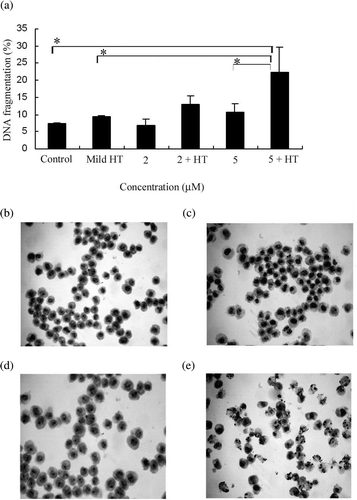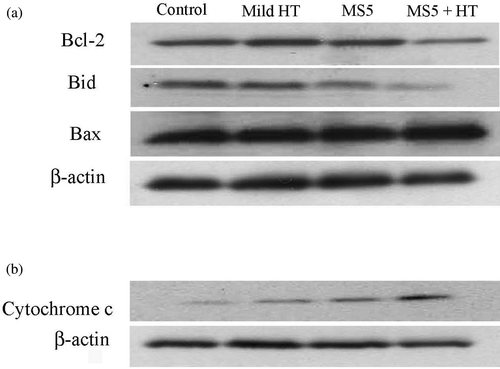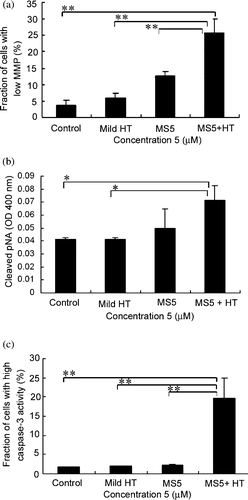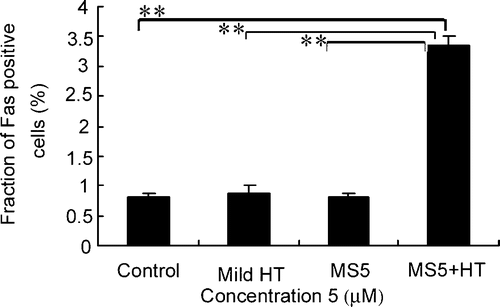Figures & data
Figure 2. Apoptotic features induced by the combination of mild HT and MS5. (a) DNA fragmentation induced by MS5 and mild HT. U937 cells were treated with 2 µM and 5 µM concentrations of MS5 alone and in combination with mild HT (41°C, 20 min) and incubated for 6 h followed by DNA fragmentation assay. Bars indicate standard deviation (n = 3; *p < 0.05). (b) Morphological changes induced by mild HT and MS5 in U937 cells. Cells were treated with MS5 (5 µM) with or without heat shock (41°C, 20 min) and then harvested after incubation for 6 h. Signs of apoptosis were detected by Giemsa staining and examined under a microscope at a magnification of ×400. (b) Control (c) mild HT (d) MS5 (e) MS5 + HT.

Figure 3. Effects of MS5 and mild HT on ROS generation and on cell growth. (a) U937 cells were first incubated with DCFH-DA for 30 min and then treated with MS5, mild HT alone and in combination of both. Intracellular H2O2 production was measured by flow cytometry immediately after treatment. (b) Time-dependent effect on cell growth was determined by trypan blue dye exclusion test. Bars indicate standard deviation (n = 3).

Figure 4. Changes in the expression of Bcl-2 family proteins and cytochrome c release. U937 cells were treated with MS5 (5 µM) and mild HT (41°C) alone and in combination. (a) Changes in the expression of Bcl-2 family, and (b) release of cytochrome c into the cytosol were monitored by western blotting.

Figure 5. Assessment of mitochondria-caspase pathway. (a) Loss of MMP; (b) Activation of caspase-8 was detected by measuring cleaved p-nitroanilide (pNA) as described in the Materials and methods; (c) Activation of caspase-3. Bars indicate standard deviation (n = 3; *p < 0.05, **p < 0.01).

Figure 6. Effects of mild HT and MS5 on Fas externalization. U937 cells were treated with MS5, mild HT alone and in combination of both for 30 min followed by flow cytometry to measure externalization of Fas by using anti-Fas FITC-conjugated antibody. Bars indicate standard deviation (n = 3; **p < 0.01).


![Figure 7. Assessment of [Ca2+]i. Cells were stained with Fura-2/AM and then immediately treated with heat with or without MS5. Time-dependent images of Fura-2 fluorescence: (a) immediately after the treatment, (b) after 1 h, (c) after 2 h, (d) after 4 h, and (e) after 6 h incubation.](/cms/asset/b05a93f6-3c71-42c1-96ab-568b9bf55a69/ihyt_a_229872_f0007_b.gif)
![Figure 8. Assessment of [Ca2+]i. Cells were stained with Fura-2/AM and then immediately treated with heat with or without MS5. Histograms of [Ca2+]i. (a) Immediately after treatment. (b) After 6 h incubation with MS5, mild HT alone and in combination.](/cms/asset/1863724b-7fbb-422b-a45e-3bd8e21e892e/ihyt_a_229872_f0008_b.gif)